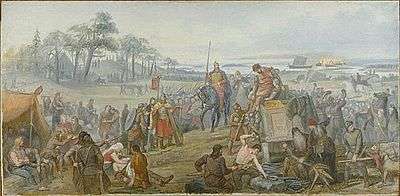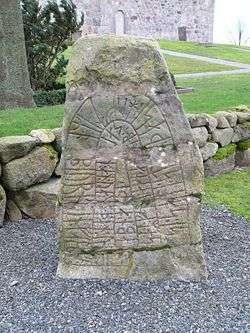Battle of Fýrisvellir
| Battle of Fýrisvellir | |||||||
|---|---|---|---|---|---|---|---|
 After the battle of Fýrisvellir, by Mårten Eskil Winge (1888). | |||||||
| |||||||
| Belligerents | |||||||
| The Swedish leidang | Jomsvikings | ||||||
| Commanders and leaders | |||||||
| Eric the Victorious | Styrbjörn the Strong | ||||||
| Strength | |||||||
| Thousands | Unknown | ||||||

The Battle of Fýrisvellir was a battle for the throne of Sweden which was fought in the 980s on the plain called Fýrisvellir, where modern Uppsala is situated, between King Eric the Victorious and his nephew Styrbjörn the Strong. It is mentioned in a number of medieval sources, such as Eyrbyggja saga, Knýtlinga saga, Hervarar saga and Saxo Grammaticus' Gesta Danorum (Book 10), but the most detailed account is found in the short story Styrbjarnar þáttr Svíakappa.
Prelude
Styrbjörn had made himself the ruler of the Jomsvikings but wanted to amass an even greater force in order to take the crown of Sweden, which the Swedish Thing had denied him on his father's death, a death of poisoning of which he suspected his uncle Eric.
Styrbjörn's method was to pillage far and wide in the newly created kingdom of Denmark until its king Harald Bluetooth asked for a settlement. Harald gave Styrbjörn his daughter Tyra as his wife and Styrbjörn went away, but he then returned to Denmark with 1000 longships. He forced the Danes to give him 200 ships and whoever among them he saw fit to take with him, including the king himself. He then set sail for Sweden with his armada of longships.
Battle
When Eric the Victorious learned that the navy had entered Mälaren, he sent the fiery cross in all directions and amassed the leidang at Uppsala. Þorgnýr the Lawspeaker, a friend of Eric, advised him to put stakes in the waterway which led to Uppsala. When Styrbjörn's navy arrived and saw that they could not sail further, Styrbjörn vowed never to leave Sweden, but to win or die. In order to encourage his men to fight to the death, he set the ships on fire. King Harald Bluetooth, however, did not want to take part in this and left with the Danish navy.
Styrbjörn swallowed his pride at this treachery and marched towards Uppsala with the Jomsvikings. When the Swedes wanted to stop their advance in the forest, Styrbjörn threatened to start a forest fire, and this convinced the Swedes to let Styrbjörn and his men pass through the forest without harm. Þorgnýr told king Eric to tie together cattle and harness them with spears and swords. When the enemy approached on the Fýrisvellir, thralls pushed the herd towards the Jomsvikings, which caused havoc among their ranks. However, Styrbjörn was an excellent warchief and restored order in his ranks. The fight lasted all day and in the evening there was a stalemate. The next day also ended in stalemate, even though King Eric had received large reinforcements.
During the night, Styrbjörn sacrificed to Thor, but the red-bearded god showed himself angry and foretold a great defeat. Eric, on the other hand, went to the Temple at Uppsala and sacrificed to Odin, promising himself to him after ten years. A tall man in a blue cloak and a broad-brimmed hat showed himself to Eric. It was Odin, who gave Eric a cane and told him to throw it over the Jomsvikings and to say "I give all of you to Odin".
The third day, Eric obeyed Odin's command and a hail of arrows fell over the Jomsvikings, a hail that the men called "Odin's arrows". When Styrbjörn understood that it was all over, he screamed to his men to stand and fight, thrust his banner into the soil and rushed into the Swedish army with his best champions. Few men fled that day.
Aftermath
After the victory, King Eric mounted one of the royal mounds and promised a great reward to whoever who could compose a poem about the victory. Among his ranks was an Icelandic skald named Þórvaldr Hjaltason, who immediately composed a skaldic poem about the victory, for which the king rewarded him with a golden bracelet.
As a result of this battle, King Eric became known as "the Victorious".[1]
Mentions on runestones

Runestones are counted as historic documents about the events of the Viking Age in Scandinavia. The following four runestones mention people who may have died in the battle. Note that the first runestone mentions a warleader named Tóki Gormsson and he may have been a son of the Danish king Gorm the Old, an interpretation which fits the fact that Styrbjörn was allied with another son of Gorm, Harald Bluetooth.
- The Hällestad Runestone DR 295 in Skåne says: "Áskell placed this stone in memory of Tóki Gormr's son, to him a faithful lord. He did not flee at Uppsala. Valiant men placed in memory of their brother the stone on the hill, steadied by runes. They went closest to Gormr's Tóki".
- The Sjörup Runestone, Skåne, relates: "Saxi placed this stone in memory of Ásbjörn Tófi's/Tóki's son, his partner. He did not flee at Uppsala, but slaughtered as long as he had a weapon".
- On the Högby Runestone, it says: "The good freeman Gulli had five sons. The brave champion Asmund fell on the Föri".
- The Karlevi Runestone, on the island of Öland near the water, was possibly raised by Danish warriors in memory of their war chief on their way from Uppsala.[2]
Notes
- ↑ Gwyn Jones, A History of the Vikings, Oxford University Press, 1973, p. 128.
- ↑ Karlevistenen in Nordisk familjebok (1910).
External links
- Carl L. Thunberg (2012): Slaget på Fyrisvallarna i ny tolkning (The Battle of Fýrisvellir in a New Interpretation)
- Uppsala Runforum, Uppsala University
| Wikimedia Commons has media related to Battle of Fýrisvellir. |
Coordinates: 59°52′19″N 17°36′51″E / 59.87194°N 17.61417°E